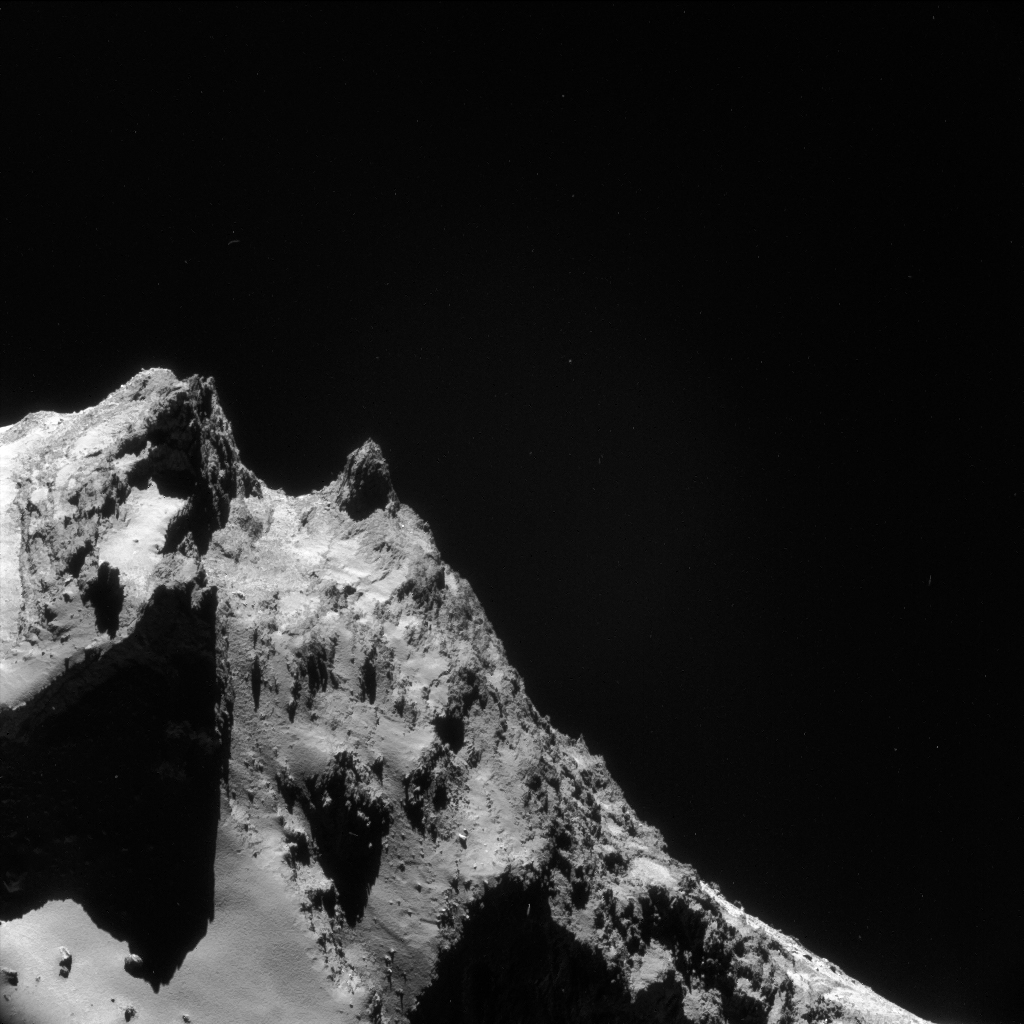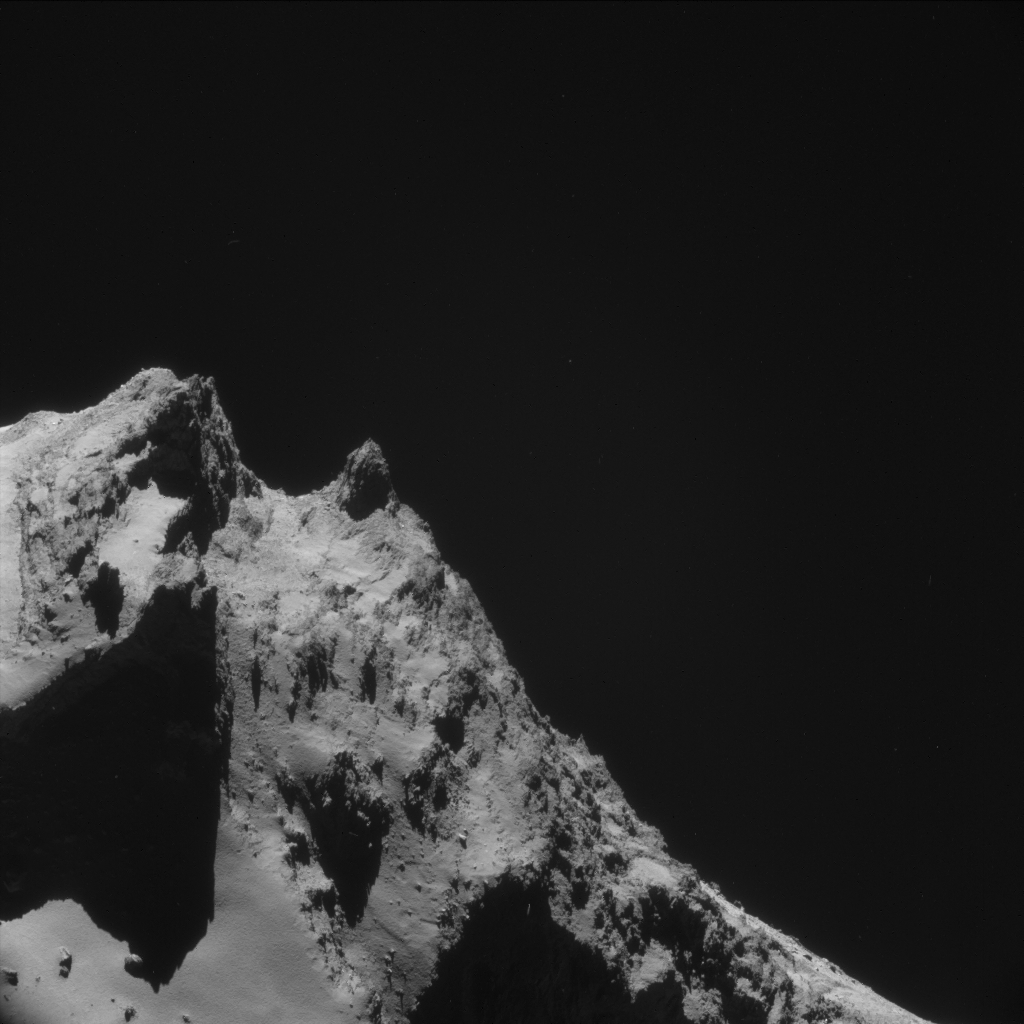A recent NAVCAM image of Comet 67P-Churyumov Gerasimenko is featured as our ESA Space Science Image of the Week.

Enhanced NAVCAM image of Comet 67P/C-G taken on 13 March 2016, 17 km from the comet nucleus. The scale is 1.5m/pixel and the image measures about 1.5 km across. Credits: ESA/Rosetta/NAVCAM – CC BY-SA IGO 3.0
Vaguely suggestive of a face immersed in deep thoughts, the image shows the rough landscape of Anuket, a region of rugged terrains on the small comet lobe and declining towards the large lobe, which is located beyond the lower-right corner of the image.
Also visible in this view are Serqet, on the upper left, Ma’at on the lower left, partly cast in shadow, and a hint of Hathor, albeit cast in shadow, in the lower part of the image.
The original NAVCAM image is provided below.










Discussion: 10 comments
Claudia: Isn’t that the C. Alexander gate?
Indeed, the crescent-like feature along the boundary between Serqet and Anuket, on the left of the image (along the edge, where Serqet declines steeply towards Anuket) is the C. Alexander Gate.
And a lovely link from Logan, back in the day:
https://www.thedailybeast.com/articles/2015/10/08/meet-claudia-alexander-nasa-badass-who-never-got-her-due.html
The Man in the Comet found!
Why don’t we get any high resolution pictures of the two or three potential final landing sites of Philae, now that Rosetta can navigate close to the comet again? Have such pictures and the actual location of Philae such a low priority compared to other investigations?
@Steven,
I’m sure there will be. Don’t forget that the closer that they can pinpoint Philae’s location to, the better they can constrain the CONSERT data.
It will not have been overlooked.
Right Steven! Philae is just round the corner from here!
:-/
There are parallel lines arranged ‘below’ both pillars of the C. Alexander Gate, as viewed in upright duck mode. In this tipped view, they are to the right of the gate, spreading along the neck. There are at least eight lines, notionally parallel and somewhat spidery-looking. They’re coming towards us which corresponds to near to vertical in the frame. They are a bit wiggly but the wiggles correspond to each other in a translational sense as you jump from line to line, from left to right. The lines therefore have translational symmetry, showing that they are somehow related.
The reason for these translational matches is that the whole of the C. Alexander Gate delaminated down the neck during neck stretch (according to stretch theory- not mainstream). These delaminations diminish in length as you go down the neck so that the line they draw goes from being quite wide in this frame (the width of the gate) to becoming two distinct, thinner lines, one for each pillar. These two lines can be traced all the way to the bottom of the neck and they meet up with the body matches to the two pillars. In other words, the gate used to be clamped to two rocky outcrops on the body. These delaminated during neck stretch, supplying material along the entire length of the neck in a ticker tape fashion. Indeed the large outcrop in the photo (the nose of the face) is the largest piece of the delaminated right hand pillar. It sits in that pillar’s delaminated line and fits to the pillar underside.
There are two more delamination lines just beyond the two for the C. Alexander Gate pillars. These too correspond to rocky outcrops on the body and can be traced all the way down the neck from their head matches to their body matches. In all four cases, the head-body matches were made before the four connecting lines were discovered . So the lines are independent corroboration of those matches. The lines are described in detail in Part 25 of the stretch blog. The head-body matches are laid out in Part 24. It amounts to unequivocal evidence that the head stretched from the body (but for readers wishing to read only peer-reviewed research, this is just a blog and, as stated above, stretch theory is not supported by the mainstream).
I like to think when Andrew says there are “all four of us” now who believe in Stretch, he means I am one of them.
For me, Andrew’s points about the neck’s stretch marks here, are among the most visually compelling for obviousness of Stretch. Second or equal is simply looking down above the head and seeing the nearly perfect match of the head perimeter shape to the body’s broken shear line “crater” from which the head arose. Thirdly are the types of terrain on each side of the head having same types of terrains on the body below. (For me)
I feel anyone just looking at hundreds of photos is at a distinct disadvantage to seeing what Andre continually has to describe in (lots of, by necessity), WORDS.
It certainly helps to have your own 3D print of Mathius Malmer’s superior 3D model in your hand to see these things easily instead of waiting and searching for certain views, (frought with ever changing lighting and shadows!)
UPS will print one for you for about $60 USD at three inches, which is about the minimum size you need to see Stretch hallmarks, although a friend D is printing me a six inch model now as a favor.
So…. do YOU have a 3D model? They are veeeerrrry cool!
Hint hint to loved ones for your birthday!
🙂 🙂 🙂
Ramcomet
Yes, you are are one of the four who have clearly stated a positive stance on stretch based on detailed observation. Furthermore, you are in the privileged position of being the only one of the three other than me who can see the matches etc with relative ease. Indeed, you said you were finding your own matches independently. Marco has often stated he needs the wordy descriptions because you can stumble away from the line being described without a very clear and detailed description. But once he’s walked the hundreds of metres along the exact line without stumbling, he can’t forget what he’s seen and is as familiar with all the detail as you and I are.
The fourth person needed some persuasion, reading Marco’s blog mostly, and over a period time. But you needed no long drawn out persuasion.
There are three or four others who commented unequivocally that they thought 67P had stretched but based only on the very general large-scale match of head to shear line or perhaps just dipping into the stretch blog. They commented in the contact binary Rosetta post in September 2015. And a couple of arty friends of mine who like you manipulate stuff in 3D- but they haven’t read the blog in detail or searched for their own matches like you. So us four are the core who support stretch theory based on a very detailed analysis of the photos.
P.S. By the way, you are asking for trouble if you say “believe in stretch” even though you go on to list the evidence to show clearly that you are using the word in the everyday sense of having a firm opinion that something is true. And that’s because your opinion is based on that firm evidence you have found. In other words, you support stretch theory based on a detailed visual analysis of the *actual comet* we are discussing because that visual analysis supports the theory. I suspect you might have to fend off semantic pedants who will pounce on the word “believe” as being akin to blind religious faith. This, despite your clear intimation that it is being used in the common, everyday secular sense of accepting something as true based on clear evidence.